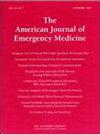Prognostic value of the lactate-to-albumin ratio for in-hospital mortality in severe acute pancreatitis with acute kidney injury: A retrospective cohort study
IF 2.2
3区 医学
Q1 EMERGENCY MEDICINE
引用次数: 0
Abstract
Background
Severe acute pancreatitis (SAP) complicated by acute kidney injury (AKI) carries a high mortality risk, and reliable early prognostic markers are needed. This study investigated the prognostic value of the lactate-to-albumin ratio (LAR) for in-hospital mortality in SAP patients with AKI.
Methods
We retrospectively analyzed 309 SAP patients with AKI admitted to a tertiary hospital between January 2016 and December 2024. Baseline demographics, laboratory data, and outcomes were collected. Logistic regression models identified independent risk factors for mortality. Receiver operating characteristic (ROC) curves, Kaplan–Meier survival analysis, and subgroup analyses evaluated the discriminative ability of LAR. Smooth curve fitting and two-piecewise linear regression assessed non-linear associations.
Results
The overall in-hospital mortality was 24.9 %. Non-survivors had significantly higher LAR than survivors (0.94 vs. 0.59, P < 0.001). In multivariable analysis, LAR independently predicted in-hospital mortality (OR: 1.33; 95 % CI: 1.01–1.77; P = 0.046). ROC analysis showed LAR had superior discriminative ability compared with lactate or albumin alone. Kaplan–Meier curves demonstrated significantly reduced survival in patients with high LAR (P < 0.001). A non-linear relationship was identified, with a mortality risk inflection point at LAR 0.69. Subgroup analyses confirmed consistent associations across clinical strata.
Conclusion
LAR is an independent and practical biomarker for predicting in-hospital mortality in SAP patients with AKI, outperforming lactate and albumin alone. Incorporating LAR into clinical assessment may improve early risk stratification and guide management decisions.
乳酸-白蛋白比值对重症急性胰腺炎合并急性肾损伤患者住院死亡率的预测价值:一项回顾性队列研究
背景:严重急性胰腺炎(SAP)合并急性肾损伤(AKI)具有很高的死亡风险,需要可靠的早期预后标志物。本研究探讨乳酸-白蛋白比值(LAR)对SAP合并AKI患者住院死亡率的预后价值。方法:回顾性分析2016年1月至2024年12月在某三级医院住院的309例SAP合并AKI患者。收集基线人口统计、实验室数据和结果。Logistic回归模型确定了死亡率的独立危险因素。受试者工作特征(ROC)曲线、Kaplan-Meier生存分析和亚组分析评估了LAR的判别能力。光滑曲线拟合和两分段线性回归评估了非线性关联。结果:住院总死亡率为24.9%。非幸存者的LAR显著高于幸存者(0.94 vs. 0.59, P)。结论:LAR是预测SAP合并AKI患者住院死亡率的独立实用生物标志物,优于单独使用乳酸和白蛋白。将LAR纳入临床评估可以改善早期风险分层和指导管理决策。
本文章由计算机程序翻译,如有差异,请以英文原文为准。
求助全文
约1分钟内获得全文
求助全文
来源期刊
CiteScore
6.00
自引率
5.60%
发文量
730
审稿时长
42 days
期刊介绍:
A distinctive blend of practicality and scholarliness makes the American Journal of Emergency Medicine a key source for information on emergency medical care. Covering all activities concerned with emergency medicine, it is the journal to turn to for information to help increase the ability to understand, recognize and treat emergency conditions. Issues contain clinical articles, case reports, review articles, editorials, international notes, book reviews and more.

 求助内容:
求助内容: 应助结果提醒方式:
应助结果提醒方式:


